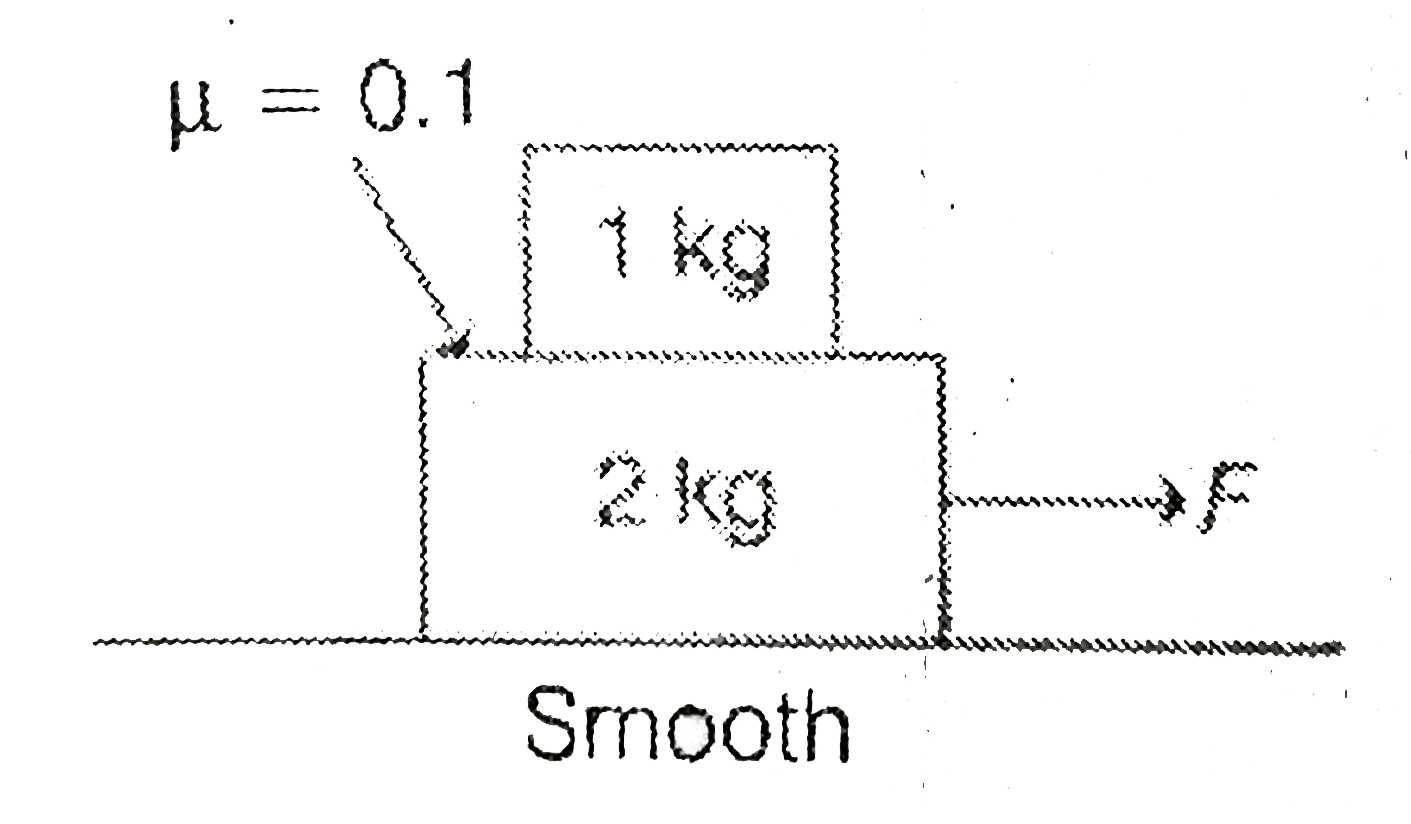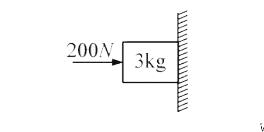A force of F=0.5 N is applied on lower block as shown in figure. The work done by lower block on upper block for a displacement of 3 m of the upper block with respect to ground is (Take, g=10 ms−2)

−0.5J
0.5 J
2 J
−2J
The correct Answer is:B
(b) Maximum acceleration of 1 kg block may be
amax=μg=1ms−2
Common acceleration, without relative motion between two blocks may be,
a=0.53ms−2
Since, a<amax
There will be no relative motion and blocks will move with acceleration 0.53ms−2.
Force of friction by lower block on upper block,
f=ma=(1)(0.53)=16N(towards right)
∴ W=f×s=0.5J
Topper's Solved these Questions
- WORK, ENERGY AND POWERBOOK - DC PANDEYCHAPTER - WORK, ENERGY AND POWEREXERCISE - MEDICAL ENTRANCE SPECIAL QUESTIONS
16 Videos
- WORK, ENERGY AND POWERBOOK - DC PANDEYCHAPTER - WORK, ENERGY AND POWEREXERCISE - MATCH THE COLUMNS
7 Videos
- WORK, ENERGY AND POWERBOOK - DC PANDEYCHAPTER - WORK, ENERGY AND POWEREXERCISE - CHECK POINT 6.3
10 Videos
- WORK, ENERGY & POWERBOOK - DC PANDEYCHAPTER - WORK, ENERGY & POWEREXERCISE - Level 2 Comprehension Based
2 Videos
- WORK, POWER AND ENERGYBOOK - DC PANDEYCHAPTER - WORK, POWER AND ENERGYEXERCISE - E Integer Type Questions
11 Videos
Similar Questions
A force of F = 0.5 N is applied on lower block as shown in figure. The work done by lower block on upper block for a displacement of 6m of the upper block with respect to ground is (in J). (Take g=10m/s2).

View SolutionA force of 0.5N is applied on upper block as shown in figure. The work done ( in joule ) by upper block on lower block for a displacement of 3m is :

View Solution
Knowledge Check
A force of 20N is applied on upper block as shown in the figure. Te total work done by frictional during the time interval in which the upper block has a displacement of 15m with respect to the ground is (take g=10m/s2 )
 A50JB−50JC75JD−75J
A50JB−50JC75JD−75JIf 100 N force is applied to 10 kg block as shown is diagram, then the acceleration produced in lower block is
 A1.65m/s2B0.89m/s2C1m/s2D0.23m/s2
A1.65m/s2B0.89m/s2C1m/s2D0.23m/s2A block of negligible size and mass 2kg is placed above a plank of mass 4kg and length 16m as shown in figure. A force of 44N is applied on the lower block as shown in the figure. The ground is smooth, coefficient of friction between upper and lower block is 0.2. Find the time after which the upper block will fall over.
 A1sB2sC3sD4s
A1sB2sC3sD4s
A small block of mass 20kg rests on a bigger block of mass 30kg, which lies on a smooth horizontal plane. Initially the whole system is at rest. The coefficient of friction between the blocks is 0.5. The horizontal force F=50N is applied on the lower block.

a. Find the work done by fricitonal force on upper block and on the lower block in t=2s.
b. Is the magnitude of work done by the frictional force on upper and lower blocks same?
c. Is the work done by the frictional force on the upper block converted to heat or mechanical energy or both?
View SolutionA block of mass 10kg is placed on a horizontal surface as shown in the figure and a force F=100N is applied on the block as shown, in the figure. The block is at rest with respect to ground. If the contact force between block and ground is 25n (in Newton) then value of n is : (Takeg=10m/s2)

View SolutionA force of 200N is applied as shown in the figure on block of 3 kg. The coefficient of friction between the block and the wall is 0.3. Find the friction acting on the block. (in N) {Take g = 10 m/s2

View SolutionA block of mass 2 kg is placed on the floor. The coefficient of static friction is 0.4. A force F of 3 N is applied on the block as shown in figure. The force of friction between the block and the floor is (Take g=10ms−2)

View SolutionA force of 100N is applied on a block of mass 3 kg as shown in the figure-2.164. The coefficient of friction between the surface and the block is 0.25.The frictional force acting on the block is: (Take g=10ms2)

View Solution
